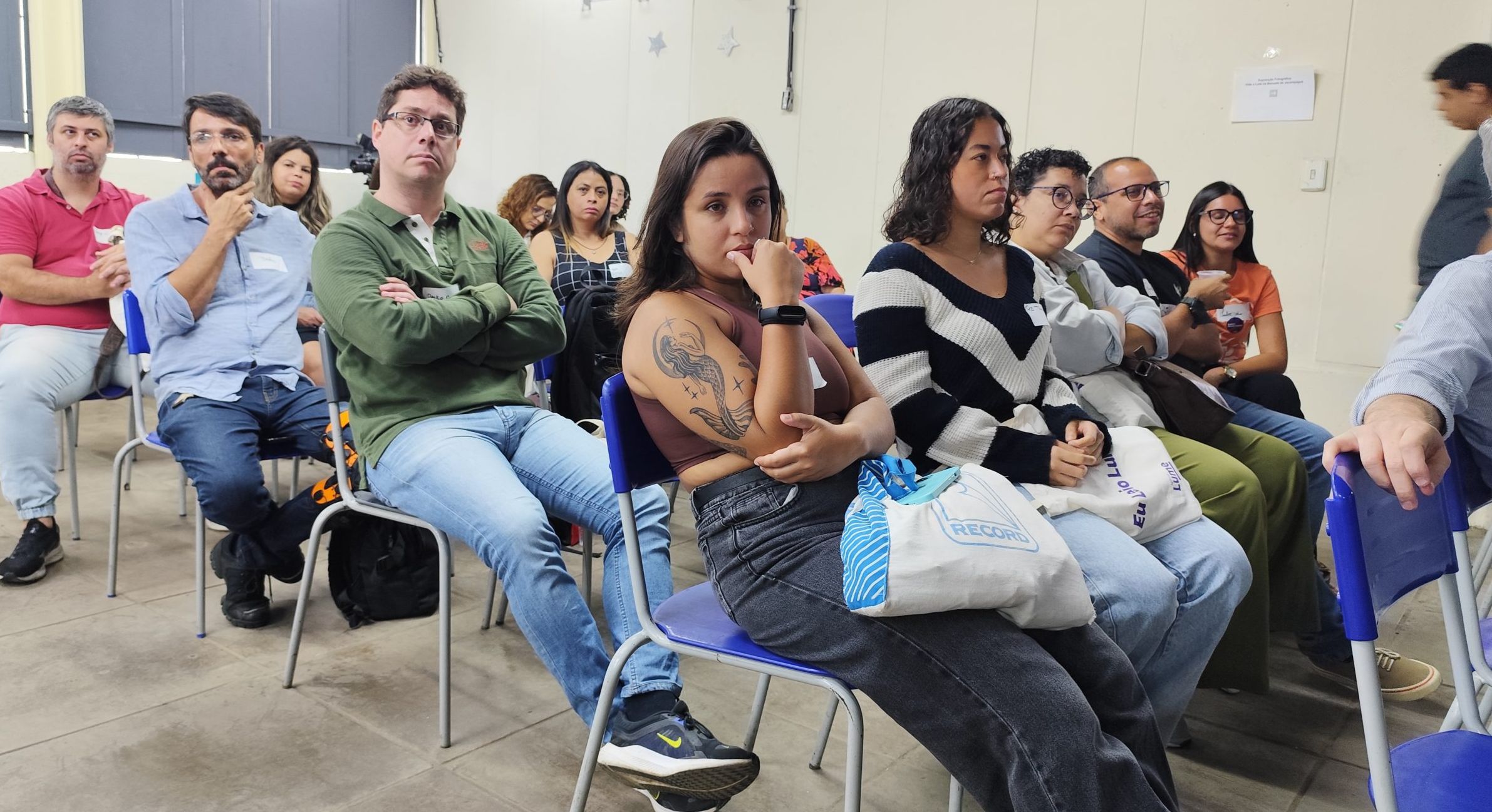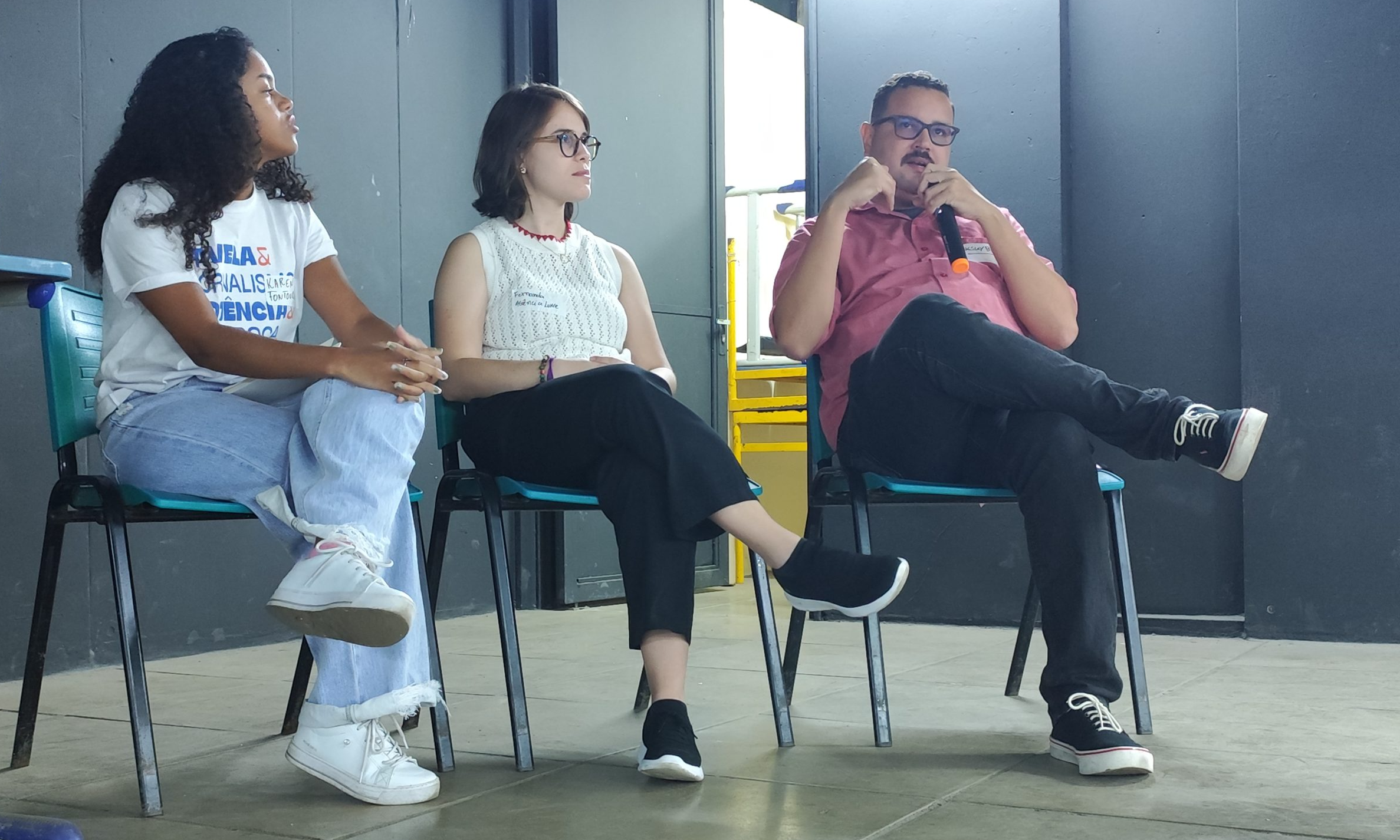
Clique aqui para Português
On November 23, community news outlet Lume Agency held an in-depth event on memory at the CAIC Euclides da Cunha secondary school in Rio das Pedras, Rio de Janeiro’s second largest favela (and fifth largest nationwide), in the city’s West Zone. Focused on the community and the flood-prone surrounding area of Baixada de Jacarepaguá, the event titled “Territories of Memory: Rio das Pedras and the Baixada de Jacarepaguá” was held in partnership with grassroots communication NGO Énois and is part of the program “Diversity in Newsrooms: Disinformation and Elections.”
The first panel, “Rio das Pedras Pride, Identities, and Challenges,” featured a discussion led by current and former residents and researchers working in the region. Participants included Adão Castro, born and raised in Rio das Pedras, who holds a PhD in Geography from the Federal University of Rio de Janeiro (UFRJ); Bruna Neres, who holds a master’s degree in Geography from the Pontifical Catholic University of Rio (PUC-Rio) and is a member of the Rio das Pedras 2030 Agenda; Fernando Tomaz, a resident of Rio das Pedras and founding member of the Conexões Periféricas communication collective; Kássia Pedrosa, who holds a master’s degree in Social Sciences from PUC-Rio and conducted a study on the memory and migration of Rio das Pedras; and Marcelo Burgos, a sociologist and coordinator of the study that resulted in the book A Utopian Community: Rio das Pedras, a Rio Favela.
“In my research, I state that it was the community of Rio das Pedras that built Rio de Janeiro and Barra [da Tijuca]! We need to think about what the city needs from the favela. We need to invert the logic… Rio das Pedras changed my identity as a human being. My vision of the world was created here. The favela is not just what we see in the newspaper, it is a place of resistance, struggle, and the production of so much culture… We can no longer live in a city that thinks about housing driven by the private sector, where public safety is designed for the upper classes and not by the favela.” — Adão Castro

For Bruna Neres, it was the stark contrast between life in Rio das Pedras and the South Zone, especially at PUC-Rio, where she studied, that led her to research and seek solutions to help the community. The geographer says that, through her experience, she decided to share knowledge from her undergraduate studies with the community, showing youth that they, too, can access higher education.
She explains that, for her master’s degree, she conducted research on urban mobility from the perspective of women in Rio das Pedras: “We believe that, more than anyone else, since we are the ones who live and experience Rio das Pedras, we are the ones who know best how to pursue the improvements we need.”
Neres also says that the interaction between social movements has a significant impact on the community, and this was one of the key motivations behind the creation of the Rio das Pedras 2030 Agenda.
“Social organizations do a lot and make an impact on the community. However, on their own, they lack the reach of government to implement changes on the scale needed to transform the lives of residents.” — Bruna Neres

In his presentation, Marcelo Burgos discussed the need to create new forms of favela representation to dismantle social and political stereotypes from the past. The sociologist also said, “The people who fight to defend democracy and justice are here, in the favela. The solidarity networks that have always characterized Rio de Janeiro have become sterilized, making this debate all the more important.”
In his talk, Fernando Tomaz emphasized that sports, culture, and education make a community stronger, showcasing the work of Conexões Periféricas in the community, including their communication courses in schools and Family Health Clinics. He stressed the importance of residents “rolling up their sleeves” to seek improvements for the community: “How much power is in our hands? Should we stop doing things for ourselves and let others take the lead? What should we do for ourselves today?”
Panel two, titled “Yakaré Upá Guá: Historical and Environmental Tourism in the Baixada de Jacarepaguá,” covered tourism in the region, with a focus on the history of the Baixada de Jacarepaguá from the Tupinambá village to the present day. The panel included Ana Melo, who holds a PhD in History and specializes in indigenous history; Enalva Lima, a tour guide at the Jacarepaguá House of Culture; Leonardo Santos, an associate professor at the Historical Institute of the Baixada de Jacarepaguá (IHBAJA); and Marcelo Calvano, the lead manager of the Clean Up Brazil Institute in Rio de Janeiro.

Mediated by Leonardo Santos, the panel underscored the indigenous origin of the region’s toponym. The name “Yakare Upá Guá” means “low lagoon of the alligators,” which gave its name to the neighborhood of Jacarepaguá, where the Rio das Pedras favela is located. Ana Melo spoke extensively about indigenous history. The historian discussed the time when the indigenous people of the Tupinambá tribe lived in the region, before the Portuguese invasion and occupation. She also commented on the importance of indigenous—and Black—labor in the development of the area during that period.
“The primary transport of sugarcane and coffee was via the sea from Barra or Irajá, as the Jacarepaguá region used to be located between these two places. The transport was carried out by indigenous rowers, who took the cargo to Guanabara Bay… Recovering history [is essential] to build a better place for people and future generations.” — Ana Melo
Enalva Lima presented the activities carried out by the Jacarepaguá House of Culture, including its guided tours and permanent exhibition on local history, as well as temporary art and craft exhibitions featuring works by the region’s artists and artisans. As a guide, she leads the route of Artur Bispo do Rosário, a former inpatient at the Colônia Juliano Moreira, which was initially established to house people with mental health issues but eventually became a neighborhood in the Baixada de Jacarepaguá. Lima also described the formation of the region by indigenous peoples and enslaved Black people, recognizing its rich history.

Marcelo Calvano became emotional as he recounted his relationship with the Baixada de Jacarepaguá. He shared that he has always wondered what he could do for the region, which he holds in great affection. Calvano also emphasized the importance of valuing the neighborhood and its residents through initiatives that support the community.
“Local tourism fosters a sense of belonging among the population and celebrates the value of the culture of the people in this territory.” — Marcelo Calvano
Closing the event, the third panel focused on communication in peripheral areas. Titled “Straight Talk: The Role of Independent and Community Media in the Fight Against Misinformation,” the discussion was led by Fernanda Calé, journalist, Executive Director, and co-founder of the Lume Agency; Karen Fontoura, journalist at Fala Roça; and Wesley Brasil, creator of Site da Baixada.

Led by Fernanda Calé, the panel addressed the challenges that community news outlets and their communicators face in delivering information to the favelas. Calé emphasized the importance of being mindful of residents’ lives when deciding to disclose (or not) specific information, while also striving to maintain neutrality due to ethical concerns.
“Sometimes we get a scoop but can’t publish it because it could put someone’s life at risk. It’s much harder for us, and expectations are even higher. We suffer more because we don’t have the wealth to keep our work going or cover the lawsuits we might face [while practicing our profession].” — Fernanda Calé
At the panel, Karen Fontoura stated that it is important to seek to inform, and to spread this information throughout the territory. “Reaching people within Rocinha is difficult, because it’s a very large community, but we’re already established as a respected outlet,” said the journalist.
“We often work with teams in the areas of health, culture, and education to make a difference in the favela, as well as partnering with universities to engage in dialogue.” — Karen Fontoura
Fontoura said that having a physical headquarters has significantly strengthened Fala Roça, encouraging residents to visit the newspaper and fostering deeper connections. However, she pointed out some of the challenges of raising funds for the newspaper, such as learning how to negotiate with companies: “We’re not usually taught how to talk about money, and that’s an issue when dealing with large corporations. One of the creative solutions we often focus on is considering local merchants as potential sponsors for the newspaper.”
Wesley Brasil stated that, in community journalism, it is important not to forget where you come from; to strive to tell stories and understand what is happening in a way that everyone in the community can grasp. Speaking about his locality, he also said that one of the challenges is to “hack” the system to eliminate the negative perception people have of the Baixada—referring here to Greater Rio’s Baixada Fluminense region, home to over 3.5 million people: “I have been trying to occupy spaces because we understand that just doing our part is not enough. We need to go further and transcend.”
During the panel, the communicator also mentioned that for media networks from peripheral areas to truly connect, they need to come together more often to discover common ground and co-create tools. Additionally, community media must embrace the challenge of learning from the new generation as a means of reaching a broader audience.
Meanwhile, Calé, one of the event organizers, spoke about the importance of events like this one, in discussing and seeking improvements for the favela.
“Lume was fortunate to bring together some really great people, folks who do incredibly important work, to share this moment of exchange. We have long believed that we can’t do anything alone, that no one can change or transform regions on their own. Everyone needs to do their part. Events like this help us connect, talk, and strengthen our region.” — Fernanda Calé
In addition to the talks and the exhibition, Agência Lume exclusively launched a new project titled “Memories: Rio das Pedras,” which seeks to tell the story of Rio das Pedras through its residents.
Teaser for Memories: Rio das Pedras:
During the “Territories of Memory: Rio das Pedras and the Baixada de Jacarepaguá” event, the Historical Institute of the Baixada de Jacarepaguá (IHBAJA) presented pieces featuring historical images of the Baixada de Jacarepaguá. Titled “Life and Struggle in the Baixada de Jacarepaguá,” the exhibition provided a glimpse into the local history for those who were not yet familiar with it.

About the author: Wellington Melo is a resident of Rio das Pedras, a Journalism graduate from UniCarioca, a former reporter with the newspaper O Dia, and a collaborative reporter with the Favelas News Agency (ANF). Melo has experience in event coverage, including the parades of the Rio de Janeiro samba schools (2020, 2022, and 2024) and Rock in Rio (2024).
